John Janaro's Blog, page 287
December 5, 2013
Advent: Playing Games With Jesus
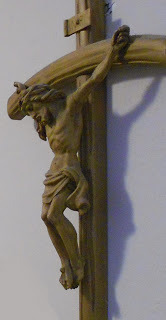 "Stir up Your power, O Lord,
"Stir up Your power, O Lord,and come to our help with mighty strength,
that what our sins impede
the grace of Your mercy may hasten.
Through our Lord Jesus Christ, Your Son,
who lives and reigns with Youin the unity of the Holy Spirit,
one God, for ever and ever."
-- Collect, from Week I of Advent
Here we are, beseeching the Lord that His power and His mighty strength might enter our lives in the form of mercy, and that this Divine Mercy might bring about by the miracle of grace the transformation of our lives by overcoming all our efforts to stop it.
Hasten (bring even more quickly) the very thing that our sins impede (the thing we try so hard to push away, run from, or ignore). Bring about by the grace of Your mercy that relationship of fulfillment for which our hearts were made, but which we cannot achieve or even understand by our own power.
I think I want to hold onto my own power and remain within the limits of what I can achieve, but He has already placed within me a deeper desire; His grace has already awakened within me the desire to be brought beyond myself to know and love Him.
This mysterious game that I play with God.
I want me to lose. I want Jesus to win.
Dear Jesus, defeat my selfishness, break down my pride, outwit my foolishness. Jesus, win me for Yourself! Make me the person You will me to become in Your wisdom and redeeming love.
Published on December 05, 2013 20:39
December 4, 2013
Woo Hoo! My Son the Basketball Player!
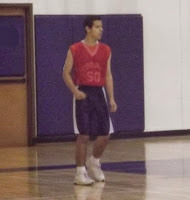 John Paul Janaro on the basketball courtAh, the basketball season has begun!
John Paul Janaro on the basketball courtAh, the basketball season has begun!Yes, I know that the big guys in NBA and NCAA have been playing for awhile already. I'm talking about the basketball season that matters, namely, Chelsea Academy's basketball season.
John Paul decided to go in for basketball this year, and he's on the JV team, which means he'll get to play... at least sometimes.
I can go back in my mind to a windy March day in the year 2006, when I set up a basketball hoop in our driveway. Back then, I had to put it on the children's height level (which I think is seven and a half feet). It was great because at that level I could do slam dunks. But it was pretty high for an eight year old boy and his little sisters. Over the years, they have thrown various spherical objects at that hoop: kid sized basketballs, soccer balls, volley balls, or any kind of bouncy ball that was handy. We probably have twenty five deflated balls somewhere in the carport.
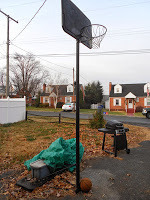 Behold: THE AMERICAN DREAM!
Behold: THE AMERICAN DREAM!(We have a barbecue grill out there too)At some point (I don't remember exactly when), we raised the height level to ten feet.
Over the years, the kids have improvised many games on that driveway, but often the old hoop was neglected. It was hard to throw a ball all the way up there.
But it was there. A basketball hoop in the driveway: my monument to The American Dream.
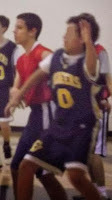 John Paul in the scrum.Now, late in the afternoon I hear <bounce, bounce, bounce, bounce> and I go outside and John Paul is popping shots from all over the driveway. Along with tennis and baseball and street hockey with roller blades, John Paul has gotten pretty good at basketball. Of course, he's not six feet nine inches tall, so this is not likely to be his road to riches and fame. That's just as well; we can focus on the fun!
John Paul in the scrum.Now, late in the afternoon I hear <bounce, bounce, bounce, bounce> and I go outside and John Paul is popping shots from all over the driveway. Along with tennis and baseball and street hockey with roller blades, John Paul has gotten pretty good at basketball. Of course, he's not six feet nine inches tall, so this is not likely to be his road to riches and fame. That's just as well; we can focus on the fun!High school basketball at this level can be a lots of fun. One reason is that hitting a shot and scoring is a big deal in these games. It is by no means to be presumed that a well executed setup will result in two points. The final scores are like 22-18. The kids have plenty of teamwork but no sharpshooters. As a result, the game resembles a soccer match except with a lot more goals: hard play, running, passing, getting into position, and then the shot which goes in... once in a while. And when it happens, we've got something to cheer about!
This is a good sports program for a small school, and especially for an academically intensive liberal arts academy. The kids get lots of exercise, learn how to work as a team, and have just enough competitive challenge to make it fun. It's a game, like it should be. Their lives don't depend on it. Nevertheless, they're playing the game because they want to win! No doubt about that.
LET'S GO CHELSEA!
Published on December 04, 2013 19:00
December 1, 2013
Charles de Foucauld and the New Evangelization
 It's December 1st again. This year it's the first Sunday of Advent, but it's a day that will always draw my mind and my soul to the memory of this great heart burning in the desert, who poured out his life's blood 98 years ago today.
It's December 1st again. This year it's the first Sunday of Advent, but it's a day that will always draw my mind and my soul to the memory of this great heart burning in the desert, who poured out his life's blood 98 years ago today.Blessed Charles de Foucauld sought Jesus by dwelling in the midst of the poorest and most forgotten peoples, and dedicating himself to their service. He lived as the presence of the love of Jesus among the desert nomads at the margins of the Islamic world.
He took the lowest place and became the servant of everyone, calling himself the "little brother" of Jesus, and in his lonely and obscure death he sowed in that mountainous desert the seeds of those ways of witnessing to God that we are searching for today. We must follow him by seeking Jesus in prayer and love, in the Eucharist and in the face of every human person.
"We are all children of the Most High. All of us: the poorest, the most outcast, a newborn child, a decrepit old person, the least intelligent human being, the most abject, an idiot, a fool, a sometimes sinner, the greatest sinner, the most ignorant, the last of the last, the one most physically and morally repugnant - all children of God and sons and daughters of the Most High. We should hold all human beings in high esteem. We should love all humankind, for they are all children of God."
-- Blessed Charles de Foucauld
Published on December 01, 2013 19:50
November 30, 2013
Andrew and Peter: Following Jesus Together
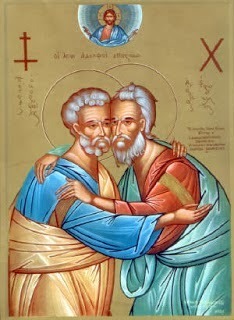 St. Andrew "the First-called" is greatly venerated in the East, especially by the see of Constantinople, which traces its origin to him. Andrew was Peter's brother, and undoubtedly unity between the brothers is his greatest concern. Let us therefore join with Pope Francis and Patriarch Bartholomew I and pray for unity, on this special day for Christians West and East, Latin Catholic, Byzantine Catholic, and Orthodox.
St. Andrew "the First-called" is greatly venerated in the East, especially by the see of Constantinople, which traces its origin to him. Andrew was Peter's brother, and undoubtedly unity between the brothers is his greatest concern. Let us therefore join with Pope Francis and Patriarch Bartholomew I and pray for unity, on this special day for Christians West and East, Latin Catholic, Byzantine Catholic, and Orthodox.As the Pope said in his message, the persecution of Christians today in the Middle East, as well as in many places throughout the world, gives this impetus for unity an added urgency. So also does the call for the New Evangelization. "Christians of East and West must give common witness so that, strengthened by the Spirit of the risen Christ, they may disseminate the message of salvation to the entire world" (Message to the Ecumenical Patriarch of Constantinople for November 30, 2013).
I love the Kontakion for the day in the Byzantine Liturgy:
"Let us praise for his courage Andrew the Theologian, first Apostle of the Savior and brother of Peter, for in like manner as he drew his brother to Christ, he is crying out to us: 'Come, for we have found the One the world desires!'"
In the prayer, St. Andrew calls Jesus "the One the world desires." We have been created for Him. Our hearts are made for Him. The meaning and mysterious reality of the very impetus of life -- desire -- finds its fulfillment in Him.
Perhaps it sounds strange, disappointing, or even incomprehensible at first: "So the meaning of my life is someone from Nazareth in Galilee who was born two thousand years ago?"
Even then, Nathaniel understood this feeling very well. His reaction to this news was, "can anything good come out of Nazareth?" And the reply was, "Come and see!"
So the Church says today, "Come and see." And just like the first disciples, the Church does not say, "come and see how great we are." She says, "Come and see that Christ is present, here, not by virtue of any power or greatness of ours, but by virtue of His own promise."
Published on November 30, 2013 20:35
November 29, 2013
Scenes From the Janaro's Thanksgiving Table
We had a beautiful Thanksgiving day, with much to be grateful for. I put together a photo album with a few highlights and (mostly) brief identifying comments. I thought it would be worth sharing here too.
This is primarily a display of the outstanding artwork of the incredible Mrs. Eileen Janaro, assisted by her apprentices. And it gives us the latest look at the children (and young people) of the family.
First, we have the place setting:
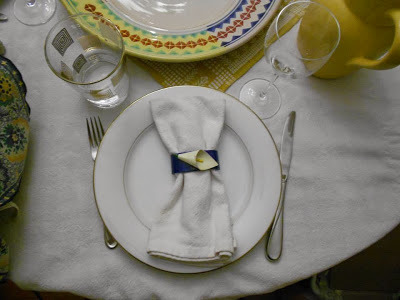
And here's the "star of the show," right out of the oven:
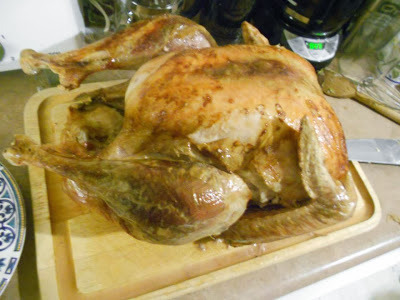
Josefina is thankful:
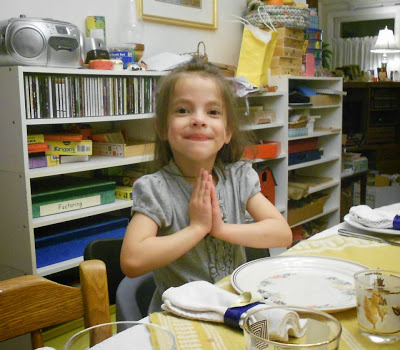
Mashed potatoes and sweet potatoes:
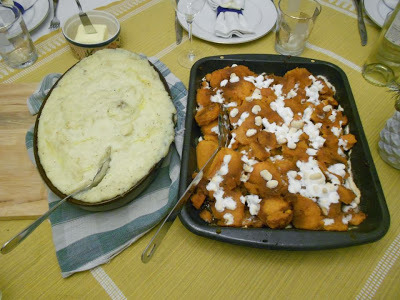
One of the plates of turkey, creatively garnished with an onion:
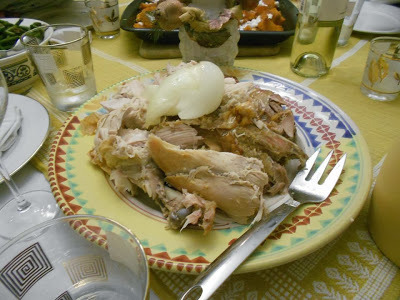
Cranberry sauce (get this) made from REAL fresh Cranberries! Oh my, this was good! Some people don't even know what actual Cranberries look like. They think they're can-shaped, hahaha:
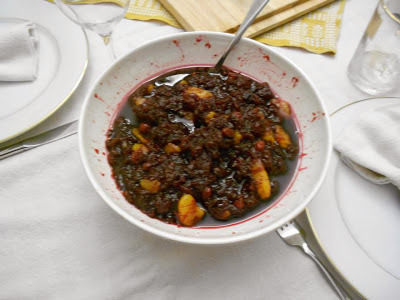
And the wine. A white wine made from grapes picked on the first full moon after the Autumn equinox, pressed before dawn the next day (very important) and then aged in three different kinds of casks, the first made from the wood of the Black Forest, the second from the great Ash trees of the Siberian tundra, and the third a coral cask fashioned from shellfish from off the coast of Patagonia. It's fresh and woody, with a hint of apricots and Burgundian winter grass. Bottled with the most technologically advanced, "naturale" twist top designed to be removed by hand! (okay, haha, that's enough... you know I'm joking, except for the twist top, which is cleverly hidden in this photo...) Here it is:
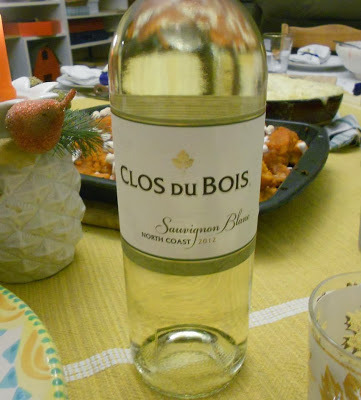
Now let's see some growing kids! John Paul and Lucia Janaro:
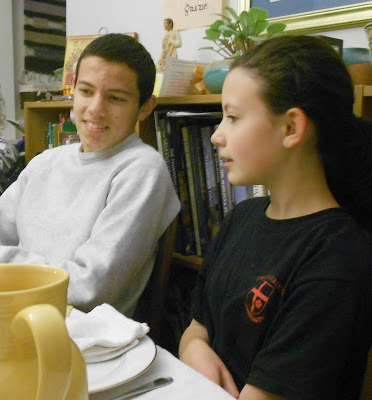
Left to right, Agnese Janaro (who will turn 15 in a few weeks), "Uncle Walter," and John Paul:
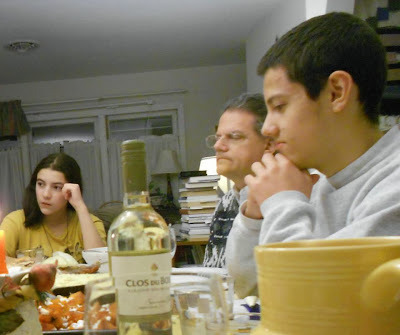
Agnese! It is very difficult to photograph this young lady, who usually dashes away from cameras. This was a lucky shot!
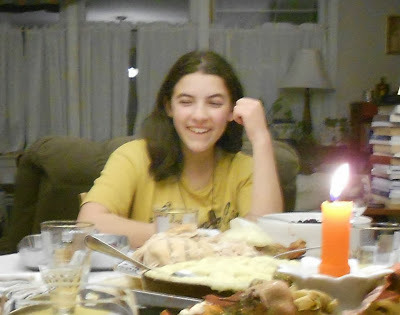
Josefina and Teresa (who will turn 11 next week). Teresa is hamming it up: "Let's EAT!"
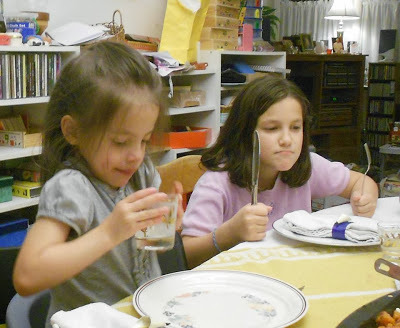
Jojo has no intention of being outdone in the "hammy" department. Teresa looks like she's thinking, "O boy!"
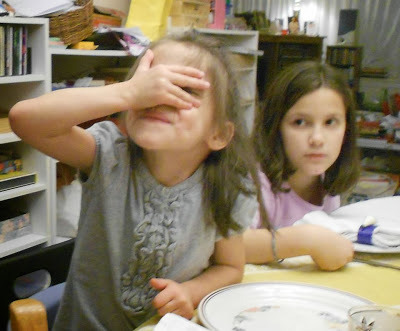
Okay, so we ate! A full plate of goodies (also string beans and mushrooms):
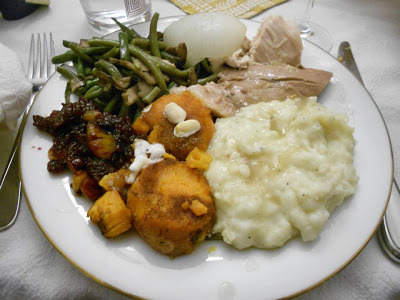
Then, after a break (obviously), came the freshly baked pies, pumpkin, apple, and pecan. Truly Eileen Janaro is amazing. She did not want her own picture taken on this occasion. So we must admire her beauty through her work:
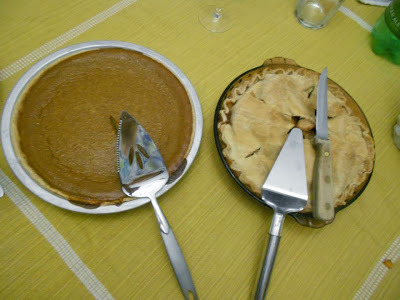
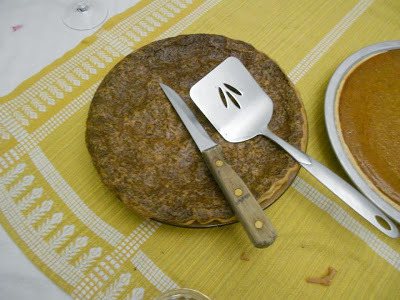
Top it off with freshly whipped cream:

What a splendid feast, a lot of which is still left over. But with our bunch, leftovers disappear pretty fast.
Happy Thanksgiving Weekend!
This is primarily a display of the outstanding artwork of the incredible Mrs. Eileen Janaro, assisted by her apprentices. And it gives us the latest look at the children (and young people) of the family.
First, we have the place setting:

And here's the "star of the show," right out of the oven:

Josefina is thankful:

Mashed potatoes and sweet potatoes:

One of the plates of turkey, creatively garnished with an onion:

Cranberry sauce (get this) made from REAL fresh Cranberries! Oh my, this was good! Some people don't even know what actual Cranberries look like. They think they're can-shaped, hahaha:

And the wine. A white wine made from grapes picked on the first full moon after the Autumn equinox, pressed before dawn the next day (very important) and then aged in three different kinds of casks, the first made from the wood of the Black Forest, the second from the great Ash trees of the Siberian tundra, and the third a coral cask fashioned from shellfish from off the coast of Patagonia. It's fresh and woody, with a hint of apricots and Burgundian winter grass. Bottled with the most technologically advanced, "naturale" twist top designed to be removed by hand! (okay, haha, that's enough... you know I'm joking, except for the twist top, which is cleverly hidden in this photo...) Here it is:

Now let's see some growing kids! John Paul and Lucia Janaro:

Left to right, Agnese Janaro (who will turn 15 in a few weeks), "Uncle Walter," and John Paul:

Agnese! It is very difficult to photograph this young lady, who usually dashes away from cameras. This was a lucky shot!

Josefina and Teresa (who will turn 11 next week). Teresa is hamming it up: "Let's EAT!"

Jojo has no intention of being outdone in the "hammy" department. Teresa looks like she's thinking, "O boy!"

Okay, so we ate! A full plate of goodies (also string beans and mushrooms):

Then, after a break (obviously), came the freshly baked pies, pumpkin, apple, and pecan. Truly Eileen Janaro is amazing. She did not want her own picture taken on this occasion. So we must admire her beauty through her work:


Top it off with freshly whipped cream:

What a splendid feast, a lot of which is still left over. But with our bunch, leftovers disappear pretty fast.
Happy Thanksgiving Weekend!
Published on November 29, 2013 19:30
November 28, 2013
On Thanksgiving: Compassion For Those Who Mourn

Happy Thanksgiving! May God bless you all, especially those of you who may not feel very happy this year, who perhaps may even find it difficult to be thankful, who are struggling, who are just wondering, "Why?"Let me make clear that this is not intended to be a "blue" post. I am writing about this precisely because of my faith that, in the end, gratitude is something true. I believe that we can take the risk of being grateful in our lives because we know that our lives are real, and that they are leading toward something that endures. This is what makes it possible for us to say "Happy Thanksgiving" even in circumstances that are hard; to say it and really mean it, to understand that it is not just a cruel joke on ourselves and others.
I have much to be thankful to God for, and I hope we all do. But we should remember that for many, many people, Thanksgiving and other family holidays are not "happy" -- at least not in the conventional sense of the sentiments conveyed by the greetings and well-wishing that we exchange on these days.
Many people are suffering on this Thanksgiving Day.
And we shouldn't think that these people are so far away. Holidays can cause much pain simply because of the loss of people who are no longer here to celebrate them with us. When the holiday comes, what strikes many people is the memory of a happiness they once had on these days, year after year after year, with another person or persons who are no longer here: a husband or wife, a father, a mother, a child or a brother or sister, or aunts and uncles, cousins and friends.
They're gone.
If someone thinks that there is nothing but this world and this present life, it is truly unbearable to be reminded again, in such a concrete way, of this terrible absence, of loved ones lost seemingly forever. What can people do? They may flee to distraction (maybe this is one the reasons for so much shopping -- it's trying to fill a hole). Or reduce themselves by cynicism. Or they try to stay human, but how?
They just weep.
They bleed from hearts that they allow to be wounded... again!
And they want to tear out their hearts from their breasts and lift them up to the cold, shining, dead stars and cry out, "I'M SORRY! THIS IS JUST NOT GOOD ENOUGH!!!"
"I love that person. I want that person. They are gone, but I still want, I still love! Please...."
Please.
For those of us who believe in eternal life, the separation from those we love does not cease to be a tremendous suffering (even when that suffering is suffused by the dawning light of hope). We want the person we love to be present with us. We want to see them in front of us, next to us. Why must we endure this fracture, this disconnection that has taken them away from us?
This is an enormous suffering; it is an experience that convinces us that God did not make death, and even as our faith tells us that death has been swallowed up in victory, we know also that it is a victory of suffering love, and sometimes our experience comes very close to those who can only weep and cry out from wounded hearts in the darkness.
This does not come from doubt. It comes from the depths of love.
Love Himself has cried out from a wounded heart that bore the whole weight of this mystery that is "absence". And He has that wound forever in His glorified heart.
On this day, therefore, we reach out to those who carry such sorrow. We want to console them, and we know that there is no cheap way to do it. The only way is to be willing to suffer with them, in whatever way we can. Even if it is only a very small way.
When we say, "Happy Thanksgiving" to one another today, let us do so with compassion.
Published on November 28, 2013 12:28
November 27, 2013
In November's Magnificat: Persecution and Perseverance

Persecution and Perseverance
Lord Jesus
I am struck dumb,
immobile,
inside and outside.
My heart is shrouded by this misery;
my eyes, which look upon your holy face,
are stricken, assaulted by the light,
aching red,
longing to be shut beneath their lids.
I have no voice
except an inner cry,
a mute, distressed animal whimper
that cannot even summon itself to ask for mercy.
My fingers drift
away from my hands
and the tokens of your love
are beyond their reach.
How do I pray?
O Lord, where is the longing of my prayer?
Jesus, Mercy.
Hear the struggle of breath;
Jesus, Mercy.
Hear the scream inside
the shaken contours of this skull,
with brain pierced
by some fiery blade.
O God, Love!
Hear the endless noise,
the pounding,
the howling of skin and nerve,
muscle and joint:
this cacophony of pain
that groans all through the place
where I once felt that I had a body.
Jesus, Mercy, forgive me.
Jesus, Love.
Jesus, I offer.
I long for these to be my words to you,
but lips are speechless quiver,
and thought and heart are frozen in exhaustion.
Prayer is ice that does not flow.
Prayer is a voice of distant memory;
it feels like a stiff corpse
beneath my soul’s total turmoil.
In the end, there is nothing
but the hollowness that holds a thing called me
wanting you.
I want you, Jesus.
Published in Magnificat, November 2013, pp. 381-383.
Published on November 27, 2013 20:30
November 25, 2013
Remembering Kennedy and the Power of Television
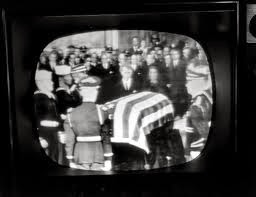 Fifty years ago: America goes to a funeral. And television discovers its power.Fifty years ago today, America attended a funeral. Millions of people brought to an end a long vigil that had begun (for most of them) sometime on the afternoon of November 22, 1963.
Fifty years ago: America goes to a funeral. And television discovers its power.Fifty years ago today, America attended a funeral. Millions of people brought to an end a long vigil that had begun (for most of them) sometime on the afternoon of November 22, 1963.It began with a shock. People remember where they were when they first heard about the unbelievable news. John F. Kennedy, the President of the United States, had been assassinated.
Among the millions was a nearly 11 month old little boy. I was later told that my mother was holding me as she wept. As one of the last of the boomers, I was born before this event took place, although I have no memory of it. Nevertheless I did grow up in its shadow; by the time I was an adolescent, it had become common for political figures to be assassinated, or at least to endure assassination attempts. Many other things that were new 50 years ago have long since become features of daily life, taken for granted. As I observe this 50th anniversary, I am struck by the fact that the Kennedy Assassination was not only a violent and tragic event in American history. It was also a singular moment in the "history of media" that I find compelling, as I try to ponder the significance and the challenges of our multi-platform, interactive, hyper-networked global village of today.
It is worth noting that the approaching years will be a time of more historic commemoration and, no doubt, reappraisal. Some events may receive more attention than others, but we are approaching many dramatic moments that mark the great shifting of historical epochs that I believe we are living through even now.
We will be marking 50 year anniversaries of the many twists and turns of that tumultuous and strange decade, the "Sixties". Far less likely to be noted by Americans are the 100 year anniversaries that will commence on June 28, 2014. This date has little hold on the contemporary imagination. Indeed, if you Google "Franz Ferdinand" your top search responses will be references to a popular music group. Wikipedia, of course, will appear to remind the curious that there was once an Austrian archduke by that name.
In contrast to November 22, there is no doubt that the assassination of June 28, 1914 was a conspiracy. It was also, unwittingly, the beginning of the unraveling of the Western world in a century of war and terror, and the rise of Something Else that we do not yet understand, but that has as one of its defining features the expanse of technological power on a Promethean scale. But I digress; I'll get back to this next June.
The rise of "Something Else" (an epoch that cannot yet be named) is part of the significance of the present anniversary, however. Technological power has affected culture in a profound way. It has affected how human beings experience public events, how they communicate them, and how these events shape their memories. November 22-25, 1963 marks the beginning of a new stage in the history of media.
President Kennedy died a tragic and untimely death by assassination, and this alone is enough to mark his place in presidential history with sorrowful memory. But something seemed different about John F. Kennedy's relationship with the American people. The people of this vast nation felt like they "knew" him; they "connected" with him through an entirely new kind of technological, but also human experience. And this experience was solidified in a singular way by the events that happened 50 years ago.
After Americans heard the news, they went to their televisions and turned them on. An entire nation gathered through the medium of television to grieve, to learn how and why it had happened, and -- as it turned out -- to witness more events unfold as Lee Harvey Oswald was captured and then was himself killed on camera by Jack Ruby. A nation watched as history unfolded, live, before their eyes. This experience, in itself, was "historic". Nothing so dramatic and intense had ever been experienced in this way before.
And 50 years ago today, America went to the funeral.
It seems almost trite now to remark that Kennedy was America's first "TV President." Multimedia are so woven into our daily experience today that it is difficult for us to conceive of the subtle but powerful innovation that occurred during his presidency. It was subtle, because by 1961 the television had already established itself as the technological hearth of the American household. But now this young, (apparently) vibrant, and articulate President became a familiar "guest" in America's living rooms.
Radio, of course, had already tilled the field of direct and "familiar" communication of a leader to his people. But video added a new dimension to this experience of familiarity (as well as new techniques of fabricating the image of familiarity). And the Kennedys were a perfect fit for making "friends" with America. Perhaps the high point of this connection was when 80 million Americans from New York to Kansas to Montana to California sat in their living rooms while being taken on a "live" tour of the White House by none other than the elegant Mrs. Kennedy herself.
This was also the age of the explosion of color photography, which also played an important role in this experience of connection. The Kennedys were everywhere.
Of course there was a great deal of illusion in all of this. The images were carefully cultivated during a time when it was still possible to keep secrets from the public. Ordinary Americans knew nothing of Kennedy's extensive marital infidelity while he was alive. But the biggest secret of all was the fact that this "vibrant young man" was chronically and even dangerously sick with Addison's disease (adrenal failure) and suffered from agonizing neuromuscular back pain. No one knew that he wore a back brace and traveled with doctors, therapists, and a virtual portable pharmacy of stimulants, painkillers, and of course the cortisone shots he needed to stay alive.
Thus the familiar feeling of Americans for their President was primarily a feeling for an "image" rather than the much more complex reality of the man himself. Of course, cultivating a public image is nothing new, but what was new was how media enabled this president to leave his audiovisual imprint upon the imaginations of millions of people. Thus he drew people's affection, and with his sudden death, he drew their grief. Public life would never be the same again.
Thus there was not only a death, but there was also a birth on November 22, 1963 and the days that followed. It was the birth of a cultural experience of historic proportions, the impact of which has perhaps surpassed the historical significance of the American President who was its subject.
A "New Medium" was born out of the sudden agony of those days. By this we mean not a new piece of technology, but a new means for human beings to participate in events. Television had awoken to the vastness of its power, which it would apply in many ways in the years to come, sometimes to clarify events and other times to manipulate them.
Television has since lost its monopoly on audiovisual media. The Newer Media have been placed in the hands of everyone. We must not forget, however, that they remain forms of power through which we can serve one another, or degrade and manipulate one another.
But there are some things that will always remain beyond our vision or any of its extensions. Beyond our power. This too we must always remember.
Rest in peace, John Fitzgerald Kennedy.
Published on November 25, 2013 12:00
November 21, 2013
Daddy and the Kids Go Round the World!
 Teresa, age 10, hanging out in pajamasGeography is great. It's fun in itself, but it can also lead to many interesting conversations. We like to just look at a globe and travel around to different places in our imaginations. Nothing on the internet comes close to replacing a good old fashioned globe that you can hold in your hands, and of course nothing will ever come close to replacing the imagination.
Teresa, age 10, hanging out in pajamasGeography is great. It's fun in itself, but it can also lead to many interesting conversations. We like to just look at a globe and travel around to different places in our imaginations. Nothing on the internet comes close to replacing a good old fashioned globe that you can hold in your hands, and of course nothing will ever come close to replacing the imagination.Give me a globe and my mind, and all the world and all of human history are at my fingertips.
And if there's a child around who is interested, it's even more fun.
The other day, Josefina found St. Helena Island all alone down there in the Atlantic ocean, and she decided to turn it into the country of her imaginary friends. Jojo and I often talk about real geography, especially the United States. But she was in a different mental mode at this point, and I wasn't about to interfere with that.
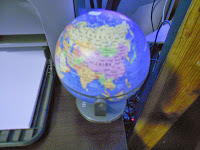 We do have bigger globes, but this will do in a pinch
We do have bigger globes, but this will do in a pinchBut later I was telling Teresa (our 10 year old) about how Josefina's imaginary friends lived in an imaginary country that was really St. Helena.
ME: "I don't think she wants to put her friends on that island. It's a miserable place!"
TERESA: "Who really lives there?"
ME: "Nobody. It was a place for British ships to stop on their way to South Africa. The only person who ever really lived there was Napoleon" (obviously that was a bit hyperbolic...).
TERESA: "Napoleon lived there?"
ME: "Yeah, he lived the last dozen years or so of his life there. That's where the British kept him prisoner."
Teresa looked at me like, wow that's pretty crazy, so I continued...
ME: "Well, he had his own house and servants and friends who came with him, and he could go anywhere he wanted on the island, but British warships circled it 24 hours a day. That's how scared they were of Napoleon Bonaparte."
TERESA: "Bonaparte? What's Bonaparte?"
ME: "His last name, Napoleon Bonaparte. His last name was Bonaparte."
I could have gone off on a tangent all about the Bonaparte family, the Corsican people, the Second Empire, but I couldn't stop laughing after she said...
TERESA: "Bonaparte? I thought his last name was Dynamite!"
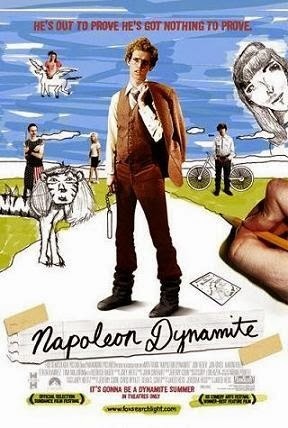 None of us have even seen this movie!
None of us have even seen this movie!
Published on November 21, 2013 20:00
November 18, 2013
From the Archives of the Antique Blog: The Journey
 More from the Antique Blog of 1990"A man going on a journey summoned his servants and entrusted his property to them; to one he gave five talents, to another two, to another one, to each according to his ability. Then he went away" (Matthew 25:14-15).
More from the Antique Blog of 1990"A man going on a journey summoned his servants and entrusted his property to them; to one he gave five talents, to another two, to another one, to each according to his ability. Then he went away" (Matthew 25:14-15).Jesus said, "A man planted a vineyard, and leased it to tenants, and went to another country for a long time" (Luke 20:9).
Something has always fascinated me about these parables. Where is the man going, and why? We're not told anything about it.
Apparently I've been thinking about this for a long time, since I wrote about it in the Antique Blog on November 18, 1990. I still wonder if there might be some mystery here, something more than a pretext for framing the story. Here's what I wrote on that day, 23 years ago:

Published on November 18, 2013 20:00



